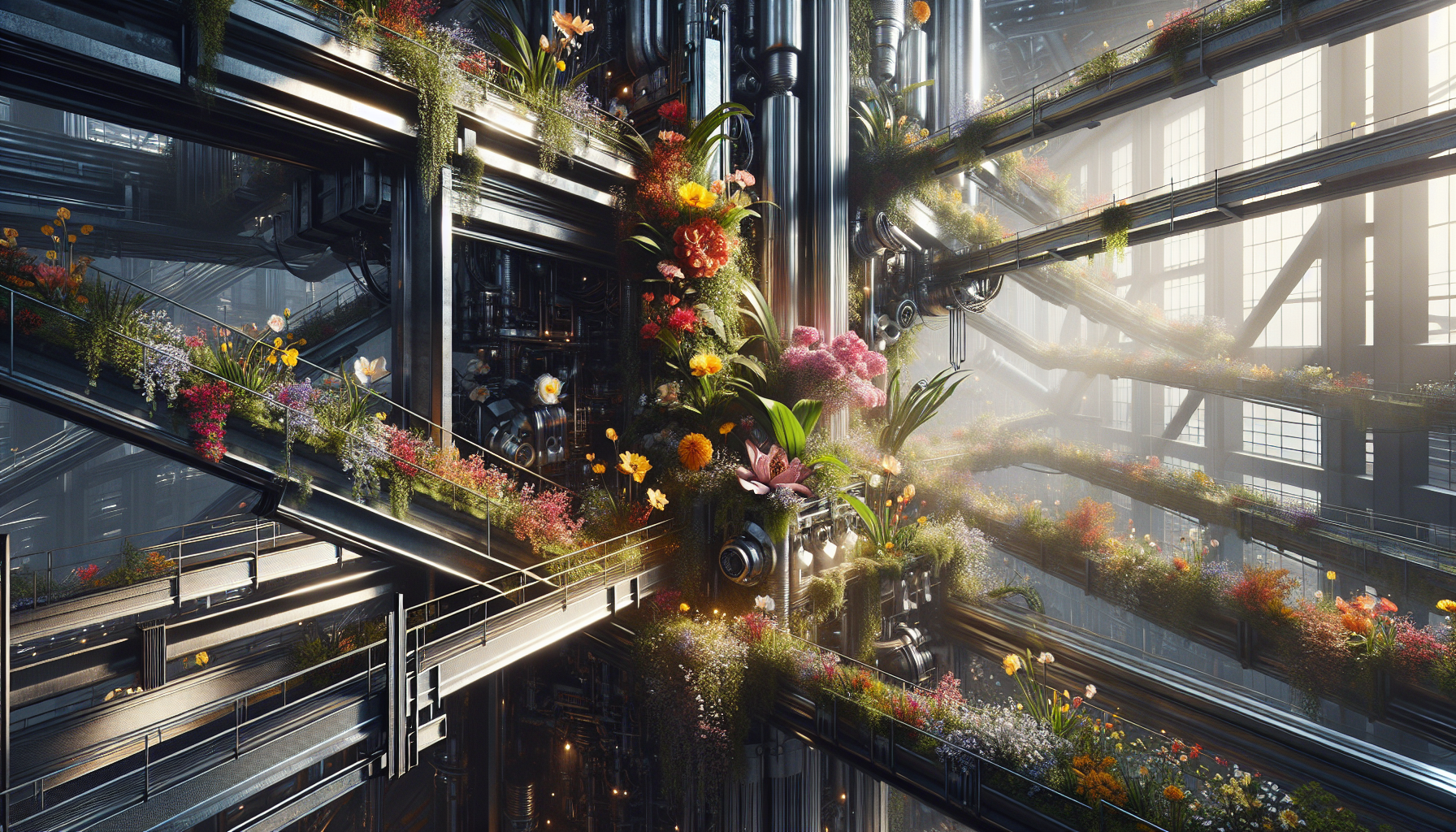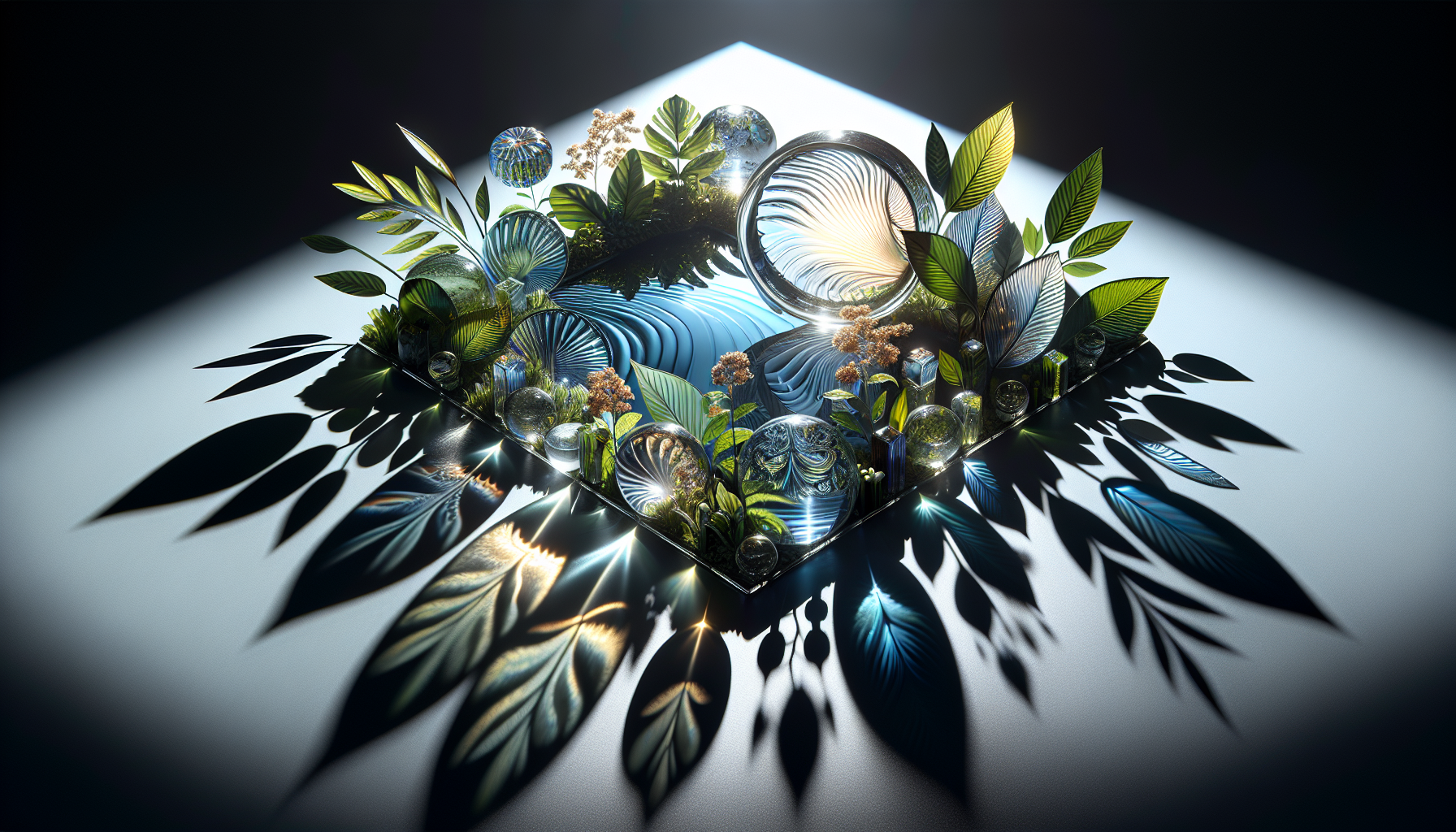Anúncios
In a world where the lines between nature and industry often seem stark and unyielding, a remarkable transformation is quietly taking place—a fusion that is as unexpected as it is harmonious. Welcome to the realm of “Unleashing Industrial Bloom: Where Raw Edge Meets Organic Elegance,” a captivating exploration into the seamless blend of the mechanical and the natural. As we embark on this journey, we’ll discover how these seemingly disparate worlds are converging to create something truly extraordinary. 🌿⚙️
Imagine a space where the gritty textures of raw metal meet the soft, flowing lines of organic design; where the stark minimalism of industrial aesthetics is gently softened by the lush vibrancy of nature. This intersection is not merely a design trend but a profound shift in the way we perceive and interact with our environments. It’s an evolution of style that speaks to our innate desire to reconnect with nature, even as we thrive in an increasingly industrialized world. The juxtaposition of these elements not only captivates the eye but also tells a deeper story about our quest for balance and harmony.
Anúncios
In the pages that follow, we’ll delve into the origins of this fascinating design movement, tracing its roots back to the early days of industrial architecture and examining its evolution into the organic forms we see today. We’ll explore the driving forces behind this trend, from the growing emphasis on sustainability to the technological advancements that make such seamless integration possible. You’ll discover how architects, designers, and artists are pushing the boundaries of creativity to craft spaces that are both functional and aesthetically pleasing, harnessing the raw power of industry while celebrating the gentle beauty of nature.
As we uncover the secrets behind this unique fusion, we’ll also look at real-world examples that bring this vision to life—from urban apartments that blend concrete and greenery to sprawling public spaces that invite both reflection and innovation. We’ll discuss the materials and techniques that are defining this movement, offering insights into how you can incorporate these elements into your own spaces. Whether you’re a design enthusiast, an industry professional, or simply someone who appreciates the art of harmonious living, this exploration promises to inspire and ignite your imagination. So, join us as we step into a world where raw edge meets organic elegance, and discover the endless possibilities that await when we dare to blur the lines between the industrial and the natural. 🌱
The Fusion of Industrial and Organic Design: A New Era of Aesthetics
In the ever-evolving world of interior design, the fusion of industrial and organic elements has emerged as a transformative trend. This marriage of raw, utilitarian aesthetics with the warmth and elegance of natural elements has given rise to a style that is both edgy and inviting. Industrial design, with its roots in factories and warehouses, is characterized by exposed brick, metal fixtures, and concrete surfaces. Organic design, on the other hand, brings in elements of nature—wood, plants, and natural light—to create a harmonious and calming environment.
Anúncios
At the core of this design philosophy is the idea of balance. The stark, hard lines of industrial design are softened by the warmth and fluidity of organic materials. This juxtaposition creates spaces that are visually striking yet comfortable and livable. Designers are increasingly gravitating towards this blend to create environments that are not only aesthetically pleasing but also sustainable and functional.
Key Elements of Industrial Design
Industrial design is characterized by its raw, unfinished look. This style celebrates the beauty of imperfection, embracing materials that are often left exposed in other design philosophies. Common features of industrial design include:
- Exposed Brick Walls: These bring a rustic charm and add texture to any space.
- Metal Fixtures: Steel, iron, and aluminum are frequently used in lighting, furniture, and architectural details.
- Concrete Surfaces: Often used for floors and countertops, concrete offers a sleek, modern finish.
- Open Spaces: Industrial design often features open floor plans with minimal walls to create a sense of spaciousness.
To delve deeper into the aesthetic of industrial design, check out this insightful video: “Understanding Industrial Design: The Basics” by The Interior Design Hub on YouTube.
Organic Elegance: Bringing Nature Indoors
Organic design is all about bringing elements of nature into indoor spaces to create a serene and soothing atmosphere. This style emphasizes the use of natural materials, such as wood, stone, and plants, to create spaces that feel alive and vibrant. Key features of organic design include:
- Natural Light: Large windows and skylights are used to maximize the flow of natural light.
- Wood Elements: Hardwood floors, wooden beams, and furniture add warmth and texture.
- Indoor Plants: Greenery is used extensively to enhance air quality and bring a touch of nature indoors.
- Sustainable Materials: Organic design often incorporates eco-friendly materials and practices.
Organic design focuses on creating spaces that are not only beautiful but also promote well-being. The use of natural elements helps reduce stress and enhances mental clarity, making it an ideal choice for both homes and workplaces.
Comparing Industrial and Organic Elements
The fusion of industrial and organic design is about finding the perfect balance between the two styles. While they may seem contradictory at first glance, when thoughtfully combined, they create a harmonious and dynamic environment. Let’s take a closer look at how these elements can be integrated:
AspectIndustrialOrganicMaterialsMetal, concrete, exposed brickWood, stone, plantsColor PaletteMonochrome, grayscaleEarth tones, natural huesTexturesRough, unfinishedSoft, naturalLightingIndustrial fixtures, Edison bulbsNatural light, soft lighting
For a more comprehensive understanding, you might want to watch this video: “Industrial vs. Organic Design: A Comparative Analysis” available on the Style & Space channel on YouTube.
Creating Balance: Tips for Designers
Achieving the perfect balance between industrial and organic elements requires careful planning and a keen eye for detail. Here are some tips for designers looking to incorporate this style into their projects:
- Start with a Neutral Base: Use neutral colors as a foundation to allow both industrial and organic elements to stand out.
- Mix Textures: Combine smooth, polished surfaces with rough, natural textures for a balanced look.
- Incorporate Greenery: Use plants to soften hard edges and add a touch of nature to industrial spaces.
- Focus on Sustainability: Choose eco-friendly materials and practices to align with the organic ethos.
By following these tips, designers can create spaces that are not only visually appealing but also sustainable and functional.
The Role of Technology in Industrial-Organic Design
Technology plays a crucial role in modern interior design, and the industrial-organic style is no exception. From smart lighting solutions to sustainable materials, technology enhances the functionality and sustainability of these spaces. Here are some ways technology is integrated into industrial-organic design:
- Smart Home Systems: Automation systems control lighting, heating, and security, enhancing convenience and energy efficiency.
- Sustainable Materials: Technological advancements have led to the development of sustainable materials, such as reclaimed wood and recycled metal.
- 3D Design Software: Designers use advanced software to visualize and plan spaces, ensuring a perfect blend of industrial and organic elements.
To see technology in action, check out this video: “Smart Technology in Modern Interior Design” from the Home Tech channel on YouTube.
Challenges and Opportunities
While the fusion of industrial and organic design offers many benefits, it also presents certain challenges. Designers must navigate the delicate balance between the raw, edgy appeal of industrial elements and the soft, calming nature of organic materials. The key is to ensure that one style does not overpower the other, maintaining harmony and coherence throughout the space.
One of the opportunities in this design style is its potential for customization. Homeowners and designers can tailor spaces to reflect personal tastes and preferences, creating unique environments that resonate on a personal level. The versatility of industrial-organic design makes it adaptable to various settings, from urban apartments to rural homes.
For a deeper dive into the challenges and opportunities in this field, watch the video: “Navigating the World of Industrial-Organic Design” on the Interior Insights channel on YouTube.

Conclusion
Conclusion: Unleashing Industrial Bloom: Where Raw Edge Meets Organic Elegance
In exploring the theme of “Unleashing Industrial Bloom: Where Raw Edge Meets Organic Elegance,” we have embarked on a journey that traverses the intricate relationship between industrial design and organic aesthetics. This convergence not only challenges traditional design paradigms but also paves the way for innovative creations that harmonize raw, industrial elements with the soft, graceful nuances of nature.
Throughout the article, we examined the historical context that laid the groundwork for this design evolution. The industrial revolution, with its robust materials and mechanical advancements, set the stage for a design ethos that prized functionality and durability. However, as society progressed, a desire for warmth, connection to nature, and sustainability began to influence design choices, giving birth to a hybrid aesthetic where industrial rawness meets organic softness.
One of the key points discussed was the importance of material selection in achieving this balance. Industrial design often emphasizes materials like steel, concrete, and glass, renowned for their strength and minimalist appeal. In contrast, organic design leans towards wood, bamboo, and other natural fibers that introduce warmth and texture. By strategically combining these materials, designers can create spaces that are not only visually captivating but also environmentally conscious.
Another significant aspect we explored was the role of sustainability. In today’s world, there is an increasing demand for designs that minimize environmental impact. The fusion of industrial and organic elements inherently supports this goal by promoting the use of recycled and upcycled materials, reducing waste, and encouraging energy efficiency. This sustainable approach not only aligns with global environmental objectives but also resonates with consumers who are increasingly aware of their ecological footprint.
Moreover, we delved into the psychological impact of this design style. Spaces that integrate industrial and organic elements often evoke a sense of calmness and inspiration. The rawness of industrial materials grounds the design, providing a stable foundation, while organic elements introduce a sense of life and fluidity. This balance can enhance well-being, productivity, and creativity, making it an ideal choice for both residential and commercial environments.
As we conclude, it is important to recognize the transformative power of design. By embracing the juxtaposition of industrial and organic elements, designers have the opportunity to create environments that are not only functional and aesthetically pleasing but also reflective of a deeper connection to the world around us. This design philosophy challenges us to rethink our approach, encouraging innovation and sustainability in equal measure.
The significance of this theme extends beyond aesthetics; it is a call to action for designers, architects, and consumers alike. We are reminded of our responsibility to create spaces that respect and honor our environment while still pushing the boundaries of creativity. As you reflect on the ideas presented in this article, consider how you might incorporate these principles into your own life and work.
We invite you to share your thoughts and experiences with this design approach. How have you seen the integration of industrial and organic elements in your own environment? What challenges and successes have you encountered? Your insights are invaluable and contribute to a broader conversation about the future of design.
Please feel free to share this article with friends, colleagues, or anyone interested in the intersection of industrial and organic design. By spreading these ideas, we can inspire others to explore new possibilities and redefine the spaces we inhabit. 🌿🏢
For further reading and inspiration, consider exploring resources such as Dezeen, Architectural Digest, and Dwell, where you can find a wealth of information on contemporary design trends and practices.
In closing, let us embrace the potential that lies at the intersection of raw edge and organic elegance. Together, we can unleash a new era of design that respects the past, cherishes the present, and looks forward to a sustainable future.
Toni Santos is a lighting artisan and visual explorer who designs atmospheres, not just objects. With a refined sensitivity to form, reflection, and emotion, Toni’s work at Sordux is an ode to how light transforms space, feeling, and story.
Through his handcrafted creations — from artistic glass bottles to radiant lighting totems — Toni invites us to see light as more than function. To him, light is symbolic. It is memory, energy, and meaning in motion.
Drawing inspiration from modern minimalism, ancestral aesthetics, and organic shapes, Toni blends natural materials with ambient expression. His collections are not just decorative — they’re immersive experiences, each one crafted to awaken the senses and reconnect us to the spaces we inhabit.
As the mind behind Sordux, Toni curates a world where illumination becomes ritual, and where every design element — from the curvature of a bottle to the hue of a glow — speaks of intention and presence.
🔥 His vision shines through:
-
Designs that merge mood with form
-
Bottled light as symbolic storytelling
-
Sustainable aesthetics rooted in artistic function
Whether you’re a designer, a dreamer, or someone who understands that light is a language of its own, Toni invites you into a world where glow becomes meaning, and every beam is an invitation to feel.




